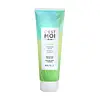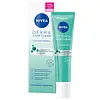What's inside
What's inside
 Key Ingredients
Key Ingredients

 Benefits
Benefits

 Concerns
Concerns

 Ingredients Side-by-side
Ingredients Side-by-side

Water
Skin ConditioningKaolin
AbrasiveZea Mays Cob Powder
AbrasiveGlycerin
HumectantCetyl Alcohol
EmollientGlyceryl Stearate Citrate
EmollientPropanediol
SolventZea Mays Kernel Meal
AbrasiveZea Mays Starch
AbsorbentCucumis Sativus Fruit Extract
EmollientSalix Alba Bark Extract
AstringentCamellia Sinensis Leaf Extract
AntimicrobialCetearyl Alcohol
EmollientVinegar
Calendula Officinalis Flower Extract
MaskingGlycyrrhiza Uralensis Root Extract
Skin ConditioningGluconolactone
Skin ConditioningCharcoal Powder
AbrasiveSodium Lauryl Glucose Carboxylate
CleansingLauryl Glucoside
CleansingCitric Acid
BufferingOryza Sativa Extract
AbsorbentMagnesium Aluminum Silicate
AbsorbentSalicylic Acid
MaskingLactic Acid
BufferingMaltodextrin
AbsorbentXanthan Gum
EmulsifyingSodium Benzoate
MaskingWater, Kaolin, Zea Mays Cob Powder, Glycerin, Cetyl Alcohol, Glyceryl Stearate Citrate, Propanediol, Zea Mays Kernel Meal, Zea Mays Starch, Cucumis Sativus Fruit Extract, Salix Alba Bark Extract, Camellia Sinensis Leaf Extract, Cetearyl Alcohol, Vinegar, Calendula Officinalis Flower Extract, Glycyrrhiza Uralensis Root Extract, Gluconolactone, Charcoal Powder, Sodium Lauryl Glucose Carboxylate, Lauryl Glucoside, Citric Acid, Oryza Sativa Extract, Magnesium Aluminum Silicate, Salicylic Acid, Lactic Acid, Maltodextrin, Xanthan Gum, Sodium Benzoate
Water
Skin ConditioningGlycolic Acid
BufferingDimethicone
EmollientGlycerin
HumectantTapioca Starch
Cetearyl Alcohol
EmollientGlyceryl Stearate
EmollientSodium Hydroxide
BufferingGluconolactone
Skin ConditioningPEG-40 Stearate
EmulsifyingPEG-150 Distearate
EmulsifyingSalicylic Acid
MaskingNiacinamide
SmoothingPanthenol
Skin ConditioningGlycyrrhiza Inflata Root Extract
Skin ConditioningPantolactone
HumectantXanthan Gum
EmulsifyingTrisodium EDTA
Citric Acid
BufferingPhenoxyethanol
PreservativeParfum
MaskingWater, Glycolic Acid, Dimethicone, Glycerin, Tapioca Starch, Cetearyl Alcohol, Glyceryl Stearate, Sodium Hydroxide, Gluconolactone, PEG-40 Stearate, PEG-150 Distearate, Salicylic Acid, Niacinamide, Panthenol, Glycyrrhiza Inflata Root Extract, Pantolactone, Xanthan Gum, Trisodium EDTA, Citric Acid, Phenoxyethanol, Parfum
 Reviews
Reviews

Ingredients Explained
These ingredients are found in both products.
Ingredients higher up in an ingredient list are typically present in a larger amount.
Cetearyl alcohol is a mixture of two fatty alcohols: cetyl alcohol and stearyl alcohol. It is mainly used as an emulsifier. Emulsifiers help prevent the separation of oils and products. Due to its composition, it can also be used to thicken a product or help create foam.
Cetearyl alcohol is an emollient. Emollients help soothe and hydrate the skin by trapping moisture.
Studies show Cetearyl alcohol is non-toxic and non-irritating. The FDA allows products labeled "alcohol-free" to have fatty alcohols.
This ingredient is usually derived from plant oils such as palm, vegetable, or coconut oils. There is debate on whether this ingredient will cause acne.
Due to the fatty acid base, this ingredient may not be Malassezia folliculitis safe.
Learn more about Cetearyl AlcoholCitric Acid is an alpha hydroxy acid (AHA) naturally found in citrus fruits like oranges, lemons, and limes.
Like other AHAs, citric acid can exfoliate skin by breaking down the bonds that hold dead skin cells together. This helps reveal smoother and brighter skin underneath.
However, this exfoliating effect only happens at high concentrations (20%) which can be hard to find in cosmetic products.
Due to this, citric acid is usually included in small amounts as a pH adjuster. This helps keep products slightly more acidic and compatible with skin's natural pH.
In skincare formulas, citric acid can:
While it can provide some skin benefits, research shows lactic acid and glycolic acid are generally more effective and less irritating exfoliants.
Most citric acid used in skincare today is made by fermenting sugars (usually from molasses). This synthetic version is identical to the natural citrus form but easier to stabilize and use in formulations.
Read more about some other popular AHA's here:
Learn more about Citric AcidGluconolactone is a PHA. PHAs are a great gentle alternative to traditional AHAs.
When applied, Gluconolactone has the same affect on skin as AHAs such as lactic acid. It helps dissolve the dead skin cells in the top layer of your skin. This improves texture and brightens the skin.
PHAs are more gentle than AHAs due to their larger structure. They do not penetrate as deeply as AHAs and take a longer time to dissolve dead cells. Studies show PHAs do not cause as much irritation.
Gluconolactone has some interesting properties:
In a 2004 study, Gluconolactone was found to prevent UV damage in mouse skin cells and has not been found to increase sun sensitivity. However, we still recommend wearing SPF daily.
This ingredient is is an created by reacting gluconic acid with an alcohol.
Learn more about GluconolactoneGlycerin is already naturally found in your skin. It helps moisturize and protect your skin.
A study from 2016 found glycerin to be more effective as a humectant than AHAs and hyaluronic acid.
As a humectant, it helps the skin stay hydrated by pulling moisture to your skin. The low molecular weight of glycerin allows it to pull moisture into the deeper layers of your skin.
Hydrated skin improves your skin barrier; Your skin barrier helps protect against irritants and bacteria.
Glycerin has also been found to have antimicrobial and antiviral properties. Due to these properties, glycerin is often used in wound and burn treatments.
In cosmetics, glycerin is usually derived from plants such as soybean or palm. However, it can also be sourced from animals, such as tallow or animal fat.
This ingredient is organic, colorless, odorless, and non-toxic.
Glycerin is the name for this ingredient in American English. British English uses Glycerol/Glycerine.
Learn more about GlycerinSalicylic Acid (also known as beta hydroxy acid or BHA) is a well-known ingredient for treating skin that struggles with acne and clogged pores. It exfoliates both the skin's surface and deep within the pores to help clear out buildup, control oil, and reduce inflammation.
Unlike AHAs (alpha hydroxy acids), salicylic acid is oil-soluble. This allows it to penetrate into pores which makes it especially effective for treating blackheads and preventing future breakouts.
Salicylic acid is also known for its soothing properties. It has a similar structure to aspirin and can calm inflamed or irritated skin, making it a good option for acne-prone skin that is also sensitive.
Concentrations of 0.5-2% are recognized by the U.S. FDA as an over-the-counter topical acne product.
It can cause irritation and/or dryness if one's skin already has a compromised moisture barrier, so it's best to focus on repairing that before introducing this ingredient into your routine.
While salicylic acid does not increase sun sensitivity, it’s still important to wear sunscreen daily to protect your skin.
If you are looking for the ingredient called BHA or Butylated Hydroxyanisole, click here.
Learn more about Salicylic AcidWater. It's the most common cosmetic ingredient of all. You'll usually see it at the top of ingredient lists, meaning that it makes up the largest part of the product.
So why is it so popular? Water most often acts as a solvent - this means that it helps dissolve other ingredients into the formulation.
You'll also recognize water as that liquid we all need to stay alive. If you see this, drink a glass of water. Stay hydrated!
Learn more about WaterXanthan gum is used as a stabilizer and thickener within cosmetic products. It helps give products a sticky, thick feeling - preventing them from being too runny.
On the technical side of things, xanthan gum is a polysaccharide - a combination consisting of multiple sugar molecules bonded together.
Xanthan gum is a pretty common and great ingredient. It is a natural, non-toxic, non-irritating ingredient that is also commonly used in food products.
Learn more about Xanthan Gum